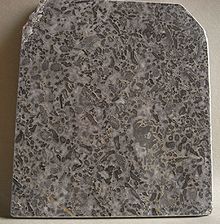Reef limestone
Reef limestone (also reef limestone ) are limestones that arise from massive accumulations of corals , sponges and other stuck marine organisms.
Emergence
Reef limestone occurs mainly in coastal or other shallow sea regions. In contrast to shill limestone , the limestone skeletons were not washed up by sea waves, but were handed down in the original habitat of the organisms, often in a living position ( in situ ).
In today's seas, reef limestone is mainly formed by hard corals . The corresponding reef bodies are therefore called coral reefs . The mostly tiny but living in large colonies coral polyps have the ability to deposit lime. Over the course of millennia, they form reefs that are meter to hundreds of meters high. The reef limestone partly consists of reef debris that was created by the ocean surf or earth movements. The structures that the reef builders created are often still recognizable in the reef limestone.
Bulk lime
Particularly powerful and extensive reef limestone deposits are often referred to as bulk limestone in order to distinguish it from the typical layered bank and plate limestone of normal sedimentation: The large reef limestone deposits are not so structured by sedimentation disturbances , they are mostly unstructured, solidified reef debris formed by wave erosion or earthquakes became, more rarely the grown reef itself.
Examples are known in Germany from the Rhenish Slate Mountains . Here, Central Devonian reef limestone form extensive deposits in the Eifel , Bergisches Land and Sauerland as well as in the Lahn-Dill area (see Lahn marble ), which are extracted in many places for cement production and as natural stone. These reef limestone are made up to a large extent of stromatopores (extinct sponge-like organisms) and extinct coral forms. Typical key fossils of this mass limestone are the arm pods (Brachiopoda) Stringocephalus burtini and Uncites gryphus .
Geologically younger mass limestones are known from the White Jura of the Swabian and Franconian Jura, which is up to 500 m thick . Especially on the Middle Kuppenalb , middle and upper (i.e. younger) layers of the White Jura are very often formed as mass limestone in the form of sponge reefs. Frequently reef limestones are also found in the Triassic of the Northern Limestone Alps , z. B. in Wettersteinkalk and Dachsteinkalk (sea-side reef zone of this lagoon limestone).
Properties and use
Reef limestone can be colored in different ways and have a banded or patchy appearance. The colors of the reef limestone are mostly whitish or yellowish, sometimes also reddish, reddish brown, brown or gray to black.
The manifestations of reef limestone are very variable due to the biological diversity in the former reefs. Typical features are individual reef fragments and bioclasts such as stromatopore parts , small pebbles from shellfish and coral parts . They come in thick, almost unlayered facies as well as in a banked form.
The reef limestone is a dense natural stone , so it is usually easy to polish. Dense reef limestone is often incorrectly referred to as marble , for example Lahn marble , but it belongs to the limestone family . Polished reef limestone is used in architecture for interior wall cladding, floor coverings and stairs. Because of their decorative effect, they were used very often for artistic and craft purposes.
Like other limestones, reef limestone is also mined as an aggregate , for example in iron smelting or for cement production.
Natural stone types
Because they can be polished, reef limestone has historically been incorrectly referred to as marbles . Some examples are:
- Vineyard marble , consisting of reef limestone rubble, Kerpen
- Cistercian marble , reef limestone, Üxheim near Gerolstein / Eifel
- Edelfels marble , reef limestone, Diez an der Lahn
- Lahn marble , formerly known as Nassau marble , Devonian reef limestone, Villmar an der Lahn
See also
literature
- Roland Vinx: Rock determination in the field. P. 313 f., 2nd edition 2008, Springer-Verlag Heidelberg 2008. ISBN 978-3-8274-1925-5
Web links
- Image of a reef lime , on geomuseum.tu-clausthal.de
- Enlarged picture of a reef limestone on geologie.uni-frankfurt.de
- Reef limestone from the Wetterstein as a pebble , on isar-kiesel.de
- Mineral Atlas: Mass Limestone




